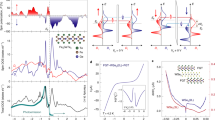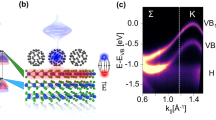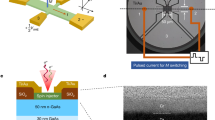Abstract
Cooling a material into a ferromagnetic phase can produce arbitrary metastable patterns of magnetic domains rather than a spatially uniform magnetic state. Control over the formation of these patterns could provide non-chemical methods of creating spintronic devices. Here we demonstrate high-efficiency optical training of magnetic domain formation in the two-dimensional van der Waals magnet Fe3GeTe2 during zero-field cooling. At ultralow power densities of around 20 µW µm−2, electrons excited by linearly polarized photons catalyse the formation of larger domains for both spin orientations. Furthermore, circularly polarized photons of the same low power density produce a single domain with its magnetization orientation determined by the optical helicity. We propose that the emergence of this single domain is caused by the optically injected spin-polarized electrons acting as initial magnetic seeds that guide different regions of the sample into the same spin orientation. Our work presents an unconventional route to tailoring spin textures in two-dimensional materials.
This is a preview of subscription content, access via your institution
Access options
Access Nature and 54 other Nature Portfolio journals
Get Nature+, our best-value online-access subscription
$32.99 / 30 days
cancel any time
Subscribe to this journal
Receive 12 print issues and online access
$259.00 per year
only $21.58 per issue
Buy this article
- Purchase on SpringerLink
- Instant access to full article PDF
Prices may be subject to local taxes which are calculated during checkout




Similar content being viewed by others
Data availability
Source data are provided with this paper. All other data relevant to this study are available from the corresponding author upon reasonable request.
Code availability
The data analysis computer codes used in this study are available from the corresponding author upon reasonable request.
Change history
04 August 2025
A Correction to this paper has been published: https://doi.org/10.1038/s41567-025-03013-5
References
Kardar, M. Statistical Physics of Fields (Cambridge Univ. Press, 2007).
Emori, S., Bauer, U., Ahn, S.-M., Martinez, E. & Beach, G. S. D. Current-driven dynamics of chiral ferromagnetic domain walls. Nat. Mater. 12, 611–616 (2013).
Jiang, W. et al. Blowing magnetic skyrmion bubbles. Science 349, 283–286 (2015).
Fu, L. & Kane, C. L. Superconducting proximity effect and majorana fermions at the surface of a topological insulator. Phys. Rev. Lett. 100, 096407 (2008).
Lambert, C.-H. et al. All-optical control of ferromagnetic thin films and nanostructures. Science 345, 1337–1340 (2014).
Wang, Y. et al. Strain-sensitive magnetization reversal of a van der Waals magnet. Adv. Mater. 32, 2004533 (2020).
Zhang, X. et al. Gate-tunable spin waves in antiferromagnetic atomic bilayers. Nat. Mater. 19, 838–842 (2020).
Basov, D. N., Averitt, R. D. & Hsieh, D. Towards properties on demand in quantum materials. Nat. Mater. 16, 1077–1088 (2017).
Jin, C. et al. Imaging and control of critical fluctuations in two-dimensional magnets. Nat. Mater. 19, 1290–1294 (2020).
Coleman, P. & Schofield, A. J. Quantum criticality. Nature 433, 226–229 (2005).
Gong, C. et al. Discovery of intrinsic ferromagnetism in two-dimensional van der Waals crystals. Nature 546, 265–269 (2017).
Huang, B. et al. Layer-dependent ferromagnetism in a van der Waals crystal down to the monolayer limit. Nature 546, 270–273 (2017).
Fei, Z. et al. Two-dimensional itinerant ferromagnetism in atomically thin Fe3GeTe2. Nat. Mater. 17, 778–782 (2018).
May, A. F. et al. Ferromagnetism near room temperature in the cleavable van der Waals crystal Fe5GeTe2. ACS Nano 13, 4436–4442 (2019).
Gong, C. & Zhang, X. Two-dimensional magnetic crystals and emergent heterostructure devices. Science 363, eaav4450 (2019).
Burch, K. S., Mandrus, D. & Park, J. G. Magnetism in two-dimensional van der Waals materials. Nature 563, 47–52 (2018).
Deng, Y. et al. Gate-tunable room-temperature ferromagnetism in two-dimensional Fe3GeTe2. Nature 563, 94–99 (2018).
Zheng, G. L. et al. Gate-tuned interlayer coupling in van der Waals ferromagnet Fe3GeTe2 nanoflakes. Phys. Rev. Lett. 125, 047202 (2020).
Liu, B. et al. Light-tunable ferromagnetism in atomically thin Fe3GeTe2 driven by femtosecond laser pulse. Phys. Rev. Lett. 125, 267205 (2020).
Zhang, P. et al. All-optical switching of magnetization in atomically thin CrI3. Nat. Mater. 21, 1373–1378 (2022).
Da̧browski, M. et al. All-optical control of spin in a 2D van der Waals magnet. Nat. Commun. 13, 5976 (2022).
Yang, M. et al. Creation of skyrmions in van der Waals ferromagnet Fe3GeTe2 on (Co/Pd)n superlattice. Sci. Adv. 6, eabb5157 (2020).
Zhao, B. et al. Room temperature spin-valve with van der Waals ferromagnet Fe5GeTe2/graphene heterostructure. Adv. Mater. 35, 2209113 (2023).
Xu, S.-Y. et al. Spontaneous gyrotropic electronic order in a transition-metal dichalcogenide. Nature 578, 545–549 (2020).
Qiu, J.-X. et al. Axion optical induction of antiferromagnetic order. Nat. Mater. 22, 583–590 (2023).
Pershoguba, S. S. & Yakovenko, V. M. Optical control of topological memory based on orbital magnetization. Phys. Rev. B 105, 064423 (2022).
Yu, T., Claassen, M., Kennes, D. M. & Sentef, M. A. Optical manipulation of domains in chiral topological superconductors. Phys. Rev. Res. 3, 013253 (2021).
Kübler, J. Theory of Itinerant Electron Magnetism (Oxford Univ. Press, 2017).
Tan, C. et al. Hard magnetic properties in nanoflake van der Waals Fe3GeTe2. Nat. Commun. 9, 1554 (2018).
Tu, Z. et al. Ambient effect on the Curie temperatures and magnetic domains in metallic two-dimensional magnets. npj 2D Mater. Appl. 5, 62 (2021).
Tan, P. H. et al. The shear mode of multilayer graphene. Nat. Mater. 11, 294–300 (2012).
Deiseroth, H.-J., Aleksandrov, K., Reiner, C., Kienle, L. & Kremer, R. K. Fe3GeTe2 and Ni3GeTe2—two new layered transition-metal compounds: crystal structures, HRTEM investigations, and magnetic and electrical properties. Eur. J. Inorg. Chem. 2006, 1561–1567 (2006).
Seo, J. et al. Nearly room temperature ferromagnetism in a magnetic metal-rich van der Waals metal. Sci. Adv. 6, eaay8912 (2020).
Stahl, J., Shlaen, E. & Johrendt, D. The van der Waals ferromagnets Fe5−δGeTe2 and Fe5−δ−xNixGeTe2—crystal structure, stacking faults, and magnetic properties. Z. Anorg. Allg. Chem. 644, 1923–1929 (2018).
May, A. F., Calder, S., Cantoni, C., Cao, H. & McGuire, M. A. Magnetic structure and phase stability of the van der Waals bonded ferromagnet Fe3−xGeTe2. Phys. Rev. B 93, 014411 (2016).
Park, S. Y. et al. Controlling the magnetic anisotropy of the van der Waals ferromagnet Fe3GeTe2 through hole doping. Nano Lett. 20, 95–100 (2020).
Kimel, A. V. et al. Ultrafast non-thermal control of magnetization by instantaneous photomagnetic pulses. Nature 435, 655–657 (2005).
Choi, G. M., Schleife, A. & Cahill, D. G. Optical-helicity-driven magnetization dynamics in metallic ferromagnets. Nat. Commun. 8, 15085 (2017).
Hassdenteufel, A. et al. Thermally assisted all-optical helicity dependent magnetic switching in amorphous Fe100−xTbx alloy films. Adv. Mater. 25, 3122–3128 (2013).
Khorsand, A. R. et al. Role of magnetic circular dichroism in all-optical magnetic recording. Phys. Rev. Lett. 108, 127205 (2012).
Lui, C. H., Liu, L., Mak, K. F., Flynn, G. W. & Heinz, T. F. Ultraflat graphene. Nature 462, 339–341 (2009).
Martin, J. et al. Observation of electron–hole puddles in graphene using a scanning single-electron transistor. Nat. Phys. 4, 144–148 (2007).
Gonzalez-Herrero, H. et al. Atomic-scale control of graphene magnetism by using hydrogen atoms. Science 352, 437–441 (2016).
Davies, J. E. et al. Magnetization reversal of Co/Pt multilayers: microscopic origin of high-field magnetic irreversibility. Phys. Rev. B 70, 224434 (2004).
Davies, J. E., Wu, J., Leighton, C. & Liu, K. Magnetization reversal and nanoscopic magnetic-phase separation in La1−xSrxCoO3. Phys. Rev. B 72, 134419 (2005).
Gilbert, D. A. et al. Quantitative decoding of interactions in tunable nanomagnet arrays using first order reversal curves. Sci. Rep. 4, 4204 (2014).
Mak, K. F. et al. Atomically thin MoS2: a new direct-gap semiconductor. Phys. Rev. Lett. 105, 136805 (2010).
Acknowledgements
C.G. acknowledges the support from the Air Force Office of Scientific Research (FA9550-22-1-0349). Sample preparation carried out by T.X. was supported by the National Science Foundation (DMR-2340773 and FuSe-2425599). Optical characterizations and optical training were supported by the National Science Foundation (DMR-2326944 and ECCS-2429994). Work at GU was supported by the National Science Foundation (DMR-2005108 and ECCS-2429995). C.G. and T.X. are grateful for the helpful discussions with P. M. Haney and L. Yang. C.G. and T.X. appreciate T. E. Murphy for technical assistance in setting up optics. T.X. is grateful for the discussion with Z. Tu.
Author information
Authors and Affiliations
Contributions
C.G. conceived the project and designed experiments. T.X. conducted 2D sample exfoliation and RMCD measurements under C.G.’s supervision. T.X., D.B., K.L. and C.G. carried out the FORC studies. T.X. and C.G. analysed the data, with helpful discussion with Z.Q.Q. H.S.A. synthesized and characterized Fe3GeTe2 and Fe5GeTe2 crystals under the supervision of D.G.M. T.X., J.L. and C.G. wrote the paper, with helpful suggestions given by V.M.Y. All authors commented on the paper.
Corresponding author
Ethics declarations
Competing interests
The authors declare no competing interests.
Peer review
Peer review information
Nature Physics thanks Saroj Dash, Liuyan Zhao and the other, anonymous, reviewer(s) for their contribution to the peer review of this work.
Additional information
Publisher’s note Springer Nature remains neutral with regard to jurisdictional claims in published maps and institutional affiliations.
Supplementary information
Supplementary Information
Supplementary Figs. 1–18 and Notes 1–4.
Source data
Source Data Fig. 1
Statistical source data.
Source Data Fig. 2
Statistical source data.
Source Data Fig. 3
Statistical source data.
Source Data Fig. 4
Statistical source data.
Rights and permissions
Springer Nature or its licensor (e.g. a society or other partner) holds exclusive rights to this article under a publishing agreement with the author(s) or other rightsholder(s); author self-archiving of the accepted manuscript version of this article is solely governed by the terms of such publishing agreement and applicable law.
About this article
Cite this article
Xie, T., Liang, J., Bhattacharya, D. et al. High-efficiency optical training of itinerant two-dimensional magnets. Nat. Phys. 21, 1118–1124 (2025). https://doi.org/10.1038/s41567-025-02928-3
Received:
Accepted:
Published:
Issue date:
DOI: https://doi.org/10.1038/s41567-025-02928-3



